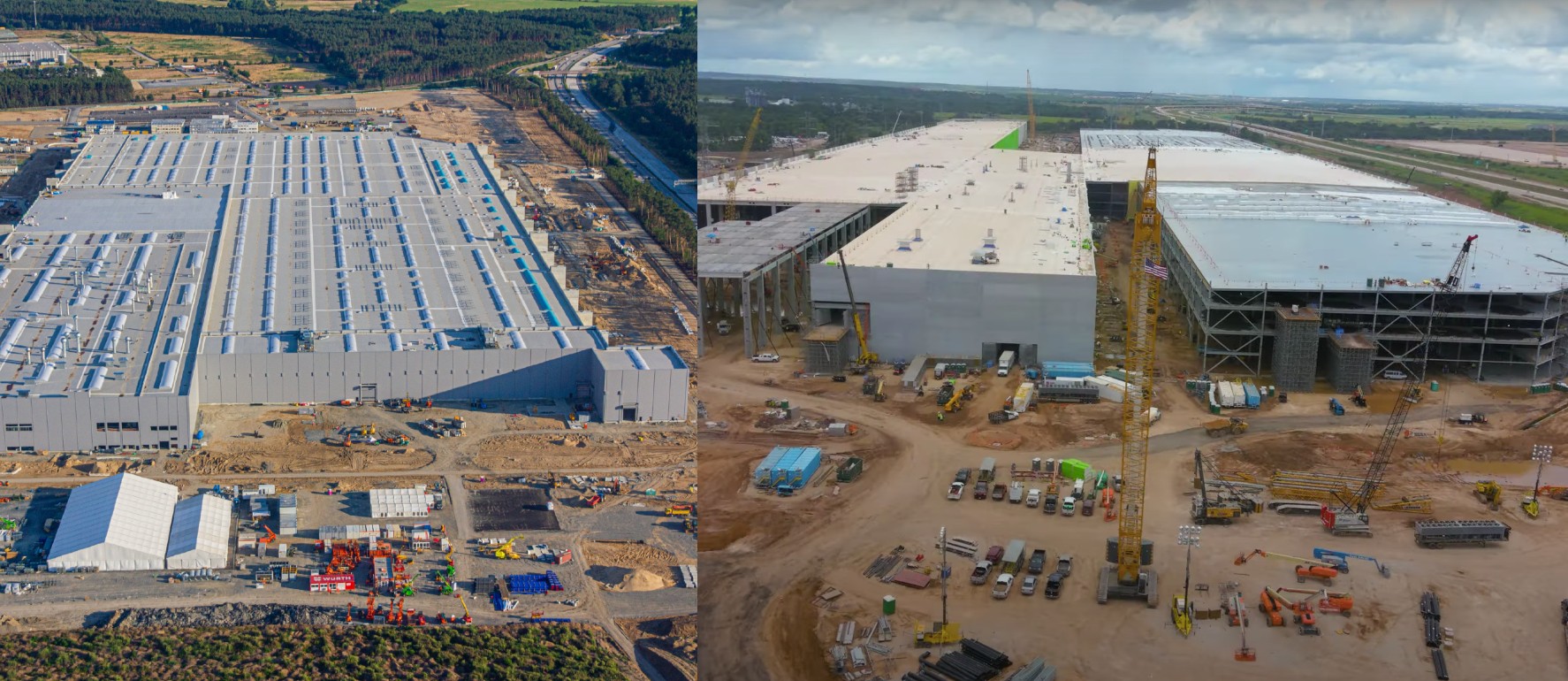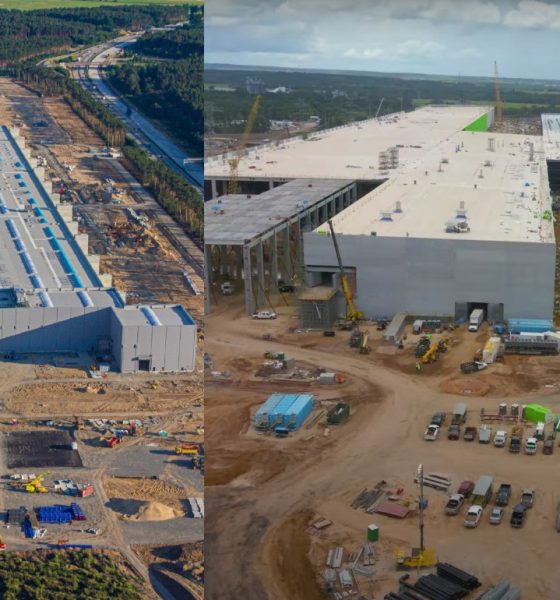

News
Tesla Giga Berlin seems on track to start Model Y production later than Giga Texas
In a recent statement to German media, Brandenburg Economics Minister Jörg Steinbach stated that he expects the final approval for Tesla’s Gigafactory Berlin facility to be released sometime in the fourth quarter of 2021. If this comes to pass, Model Y production in the facility would be starting several months or so later than expected, which may not seem like too much of a delay. It may, however, result in Gigafactory Texas, a facility that started its buildout several months after the Germany-based factory, starting its Model Y production earlier than its Germany-based sibling.
As per a report from Berlin.de, Steinbach stated that the principle of quality over speed applies in the approval process of Gigafactory Berlin. “The principle of quality over speed clearly applies in the approval process. The top priority is that the decision of the State Office for the Environment is ultimately legally secure. And the factory can only be opened once a positive approval decision has been made,” the minister said.
If the State Environment Agency refuses to grant Gigafactory Berlin’s final approval, Tesla would have to dismantle all the structures it has built on the massive Grünheide complex, which includes a plant designed to produce the Tesla Model Y. Tesla would also have to replace the monoculture forest that it cut down in the area. Steinbach, however, noted that he considers a final veto from the Environmental Agency to be practically impossible. “This is not about the approval of a new nuclear power plant,” he said.
Inasmuch as Giga Berlin is supported by the Economics Minister, there is no denying that the project is meeting a substantial amount of pushback from local entities. Legal challenges from the Naturschutzbund (Nabu) and the Green League over Giga Berlin’s latest early approval aside, Tesla is also being investigated by the Brandenburg’s State Environment Agency for allegedly constructing a refrigerant tank (which may still be empty) without permission. The complaints about Giga Berlin’s alleged “illegal” tanks were filed by the two environmental groups, and are cruelty being handled by the Berlin-Brandenburg Higher Administrative Court (OVG).
Similar issues have so far not plagued Gigafactory Texas. Since its announcement on the Q2 2020 earnings call, Giga Texas’ construction has been relatively smooth. It’s been roughly 350 days since the massive Texas-based facility was announced, and so far, trial runs for parts of the plant’s Model Y production line are already underway. Elon Musk even noted on Twitter back in April that limited production of the Model Y would begin in Gigafactory Texas this year, with volume production hitting its pace in 2022.
What is quite interesting is that Gigafactory Texas’s footprint exceeds that of Gigafactory Berlin. Tesla adopted a different pattern for Giga Texas by building large sections of the full factory immediately, and so far, such a strategy seems to be working well. However, what truly differentiates the Texas plant from its Germany-based counterpart is the amount of pushback against the project as a whole. While Giga Berlin could barely move these days without encountering loud complaints and legal actions from the Naturschutzbund (Nabu) and the Green League — or local news agencies for that matter — Giga Texas has so far been met with support.
This is quite an unfortunate situation overall, as Gigafactory Berlin actually started out strong. Following its initial announcement in November 2019, Giga Berlin’s first months showed a lot of progress, so much so that it seemed like the facility may be built faster than Gigafactory Shanghai, whose Model 3 factory was built and launched in less than a year. But just like Giga Texas, Gigafactory Shanghai was also constructed without much drama. Since its groundbreaking in January 2019, Tesla’s China-based facility has grown steadily, and today, it is already poised to export the Made-in-China Model Y to European territories.
Tesla opened orders for the Model Y in Europe recently, and the all-electric crossovers would likely be coming from Giga Shanghai. One could almost assume that Tesla opted for this strategy due to the delays in Giga Berlin. The Grünheide facility, after all, was initially expected to start Model Y production sometime in the latter half of 2021. But if Brandenburg’s Economics Minister optimistically believes that Giga Berlin’s final approval would be granted in the fourth quarter, then having Giga Shanghai’s Made-in-China Model Ys pick up the slack may indeed be a good idea.
Don’t hesitate to contact us with news tips. Just send a message to tips@teslarati.com to give us a heads up.

News
Tesla FSD fleet is nearing 7 billion total miles, including 2.5 billion city miles
As can be seen on Tesla’s official FSD webpage, vehicles equipped with the system have now navigated over 6.99 billion miles.

Tesla’s Full Self-Driving (Supervised) fleet is closing in on almost 7 billion total miles driven, as per data posted by the company on its official FSD webpage.
These figures hint at the massive scale of data fueling Tesla’s rapid FSD improvements, which have been quite notable as of late.
FSD mileage milestones
As can be seen on Tesla’s official FSD webpage, vehicles equipped with the system have now navigated over 6.99 billion miles. Tesla owner and avid FSD tester Whole Mars Catalog also shared a screenshot indicating that from the nearly 7 billion miles traveled by the FSD fleet, more than 2.5 billion miles were driven inside cities.
City miles are particularly valuable for complex urban scenarios like unprotected turns, pedestrian interactions, and traffic lights. This is also the difference-maker for FSD, as only complex solutions, such as Waymo’s self-driving taxis, operate similarly on inner-city streets. And even then, incidents such as the San Francisco blackouts have proven challenging for sensor-rich vehicles like Waymos.
Tesla’s data edge
Tesla has a number of advantages in the autonomous vehicle sector, one of which is the size of its fleet and the number of vehicles training FSD on real-world roads. Tesla’s nearly 7 billion FSD miles then allow the company to roll out updates that make its vehicles behave like they are being driven by experienced drivers, even if they are operating on their own.
So notable are Tesla’s improvements to FSD that NVIDIA Director of Robotics Jim Fan, after experiencing FSD v14, noted that the system is the first AI that passes what he described as a “Physical Turing Test.”
“Despite knowing exactly how robot learning works, I still find it magical watching the steering wheel turn by itself. First it feels surreal, next it becomes routine. Then, like the smartphone, taking it away actively hurts. This is how humanity gets rewired and glued to god-like technologies,” Fan wrote in a post on X.
News
Tesla starts showing how FSD will change lives in Europe
Local officials tested the system on narrow country roads and were impressed by FSD’s smooth, human-like driving, with some calling the service a game-changer for everyday life in areas that are far from urban centers.

Tesla has launched Europe’s first public shuttle service using Full Self-Driving (Supervised) in the rural Eifelkreis Bitburg-Prüm region of Germany, demonstrating how the technology can restore independence and mobility for people who struggle with limited transport options.
Local officials tested the system on narrow country roads and were impressed by FSD’s smooth, human-like driving, with some calling the service a game-changer for everyday life in areas that are far from urban centers.
Officials see real impact on rural residents
Arzfeld Mayor Johannes Kuhl and District Administrator Andreas Kruppert personally tested the Tesla shuttle service. This allowed them to see just how well FSD navigated winding lanes and rural roads confidently. Kruppert said, “Autonomous driving sounds like science fiction to many, but we simply see here that it works totally well in rural regions too.” Kuhl, for his part, also noted that FSD “feels like a very experienced driver.”
The pilot complements the area’s “Citizen Bus” program, which provides on-demand rides for elderly residents who can no longer drive themselves. Tesla Europe shared a video of a demonstration of the service, highlighting how FSD gives people their freedom back, even in places where public transport is not as prevalent.
What the Ministry for Economic Affairs and Transport says
Rhineland-Palatinate’s Minister Daniela Schmitt supported the project, praising the collaboration that made this “first of its kind in Europe” possible. As per the ministry, the rural rollout for the service shows FSD’s potential beyond major cities, and it delivers tangible benefits like grocery runs, doctor visits, and social connections for isolated residents.
“Reliable and flexible mobility is especially vital in rural areas. With the launch of a shuttle service using self-driving vehicles (FSD supervised) by Tesla in the Eifelkreis Bitburg-Prüm, an innovative pilot project is now getting underway that complements local community bus services. It is the first project of its kind in Europe.
“The result is a real gain for rural mobility: greater accessibility, more flexibility and tangible benefits for everyday life. A strong signal for innovation, cooperation and future-oriented mobility beyond urban centers,” the ministry wrote in a LinkedIn post.
News
Tesla China quietly posts Robotaxi-related job listing
Tesla China is currently seeking a Low Voltage Electrical Engineer to work on circuit board design for the company’s autonomous vehicles.

Tesla has posted a new job listing in Shanghai explicitly tied to its Robotaxi program, fueling speculation that the company is preparing to launch its dedicated autonomous ride-hailing service in China.
As noted in the listing, Tesla China is currently seeking a Low Voltage Electrical Engineer to work on circuit board design for the company’s autonomous vehicles.
Robotaxi-specific role
The listing, which was shared on social media platform X by industry watcher @tslaming, suggested that Tesla China is looking to fill the role urgently. The job listing itself specifically mentions that the person hired for the role will be working on the Low Voltage Hardware team, which would design the circuit boards that would serve as the nervous system of the Robotaxi.
Key tasks for the role, as indicated in the job listing, include collaboration with PCB layout, firmware, mechanical, program management, and validation teams, among other responsibilities. The role is based in Shanghai.
China Robotaxi launch
China represents a massive potential market for robotaxis, with its dense urban centers and supportive policies in select cities. Tesla has limited permission to roll out FSD in the country, though despite this, its vehicles have been hailed as among the best in the market when it comes to autonomous features. So far, at least, it appears that China supports Tesla’s FSD and Robotaxi rollout.
This was hinted at in November, when Tesla brought the Cybercab to the 8th China International Import Expo (CIIE) in Shanghai, marking the first time that the autonomous two-seater was brought to the Asia-Pacific region. The vehicle, despite not having a release date in China, received a significant amount of interest among the event’s attendees.








